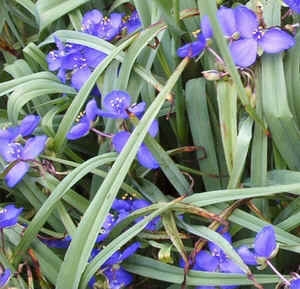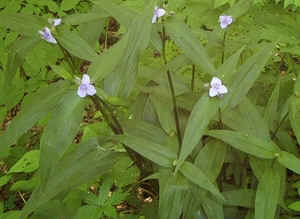 |
 |
|
| Virginia Spiderwort (Tradescantia virginiana) | Zigzag Spiderwort (Tradescantia subaspera) |
Common Name: Spiderwort, Widow's Tears
Genus: Tradescantia
Family: Commelinaceae
Blue Ridge Parkway
North Carolina
May 9, 2002
 |
 |
|
| Virginia Spiderwort (Tradescantia virginiana) | Zigzag Spiderwort (Tradescantia subaspera) |
A handsome, rather robust, fleshy native perennial 1-2 feet tall that often forms large clumps when growing under ideal soil and light conditions. The flowers, in which all three petals develop equally, are up to 1-1/4 inches across and vary from dark to light blue or even pinkish blue. Infrequent in deciduous woods and clearings and along forest margins, chiefly in the mountains and piedmont. The general range of this species is the midwest. June-July [Justice, William S. and Bell, C. Ritchie, Wild Flowers of North Carolina. University of North Carolina Press, Chapel Hill, 1968]
Its long parallel-veined leaves and jointed stems lend this plant the appearance of giant spider legs. Six yellow, bearded stamens ring the center of the three-petaled blue flower. The flower opens in the morning and, if pollinated, its petals rapidly wilt, often leaving a wet residue. This strange occurrence led to a second common name, widow's tears. Scientists use this genus for many studies because of its large chromosomes. Recently, spiderworts have been studied as natural barometers for air pollution and radiation. Severe exposure to air pollutants causes a change in flower color -- the degree of blue to purple color change indicates the amount of air pollution. June-July [White, Peter, Wildflowers of the Smokies. Great Smoky Mountains Natural History Association, Gatlinburg, 1996]
Botanists appreciate spiderwort for more than the simple loveliness of its flower. Research has proven it to be important in cell biology because of its large chromosome structure. Also, a high sensitivity to pollution and radiation causes it to mutate quickly, making it a good indicator of environmental problems. Another interesting characteristic of spiderwort is that its spent blossoms do not fall to the ground -- they seem to melt off the plant, due to the actions of certain enzymes. Tradescantia is names for John Tradescant, who was the royal gardener for King Charles I of England. April-August [Adams, Kevin and Casstevens, Marty, Wildflowers of the Southern Appalachians: How to Photograph and Identify Them. John F. Blair, Publisher, Winston-Salem, 1996]
January February March April May June July August September October November December
Alphabetical Listings -- A B C D, E F G H I, J, K L M N, O P Q, R S T U, V W X, Y, Z
Family Listings -- A B C D, E F G H I, J, K L M N, O P Q, R S T U, V W X, Y, Z
Genus Listings -- A B C D, E F G H I, J, K L M N, O P Q, R S T U, V W X, Y, Z